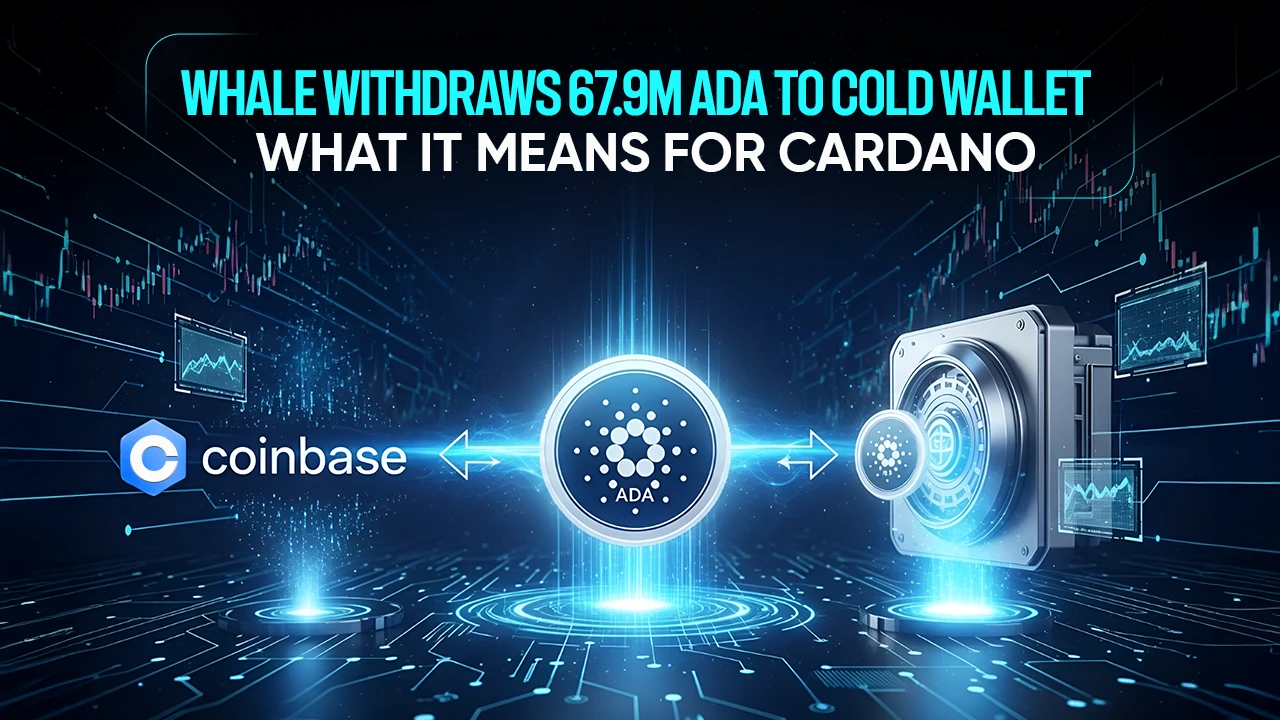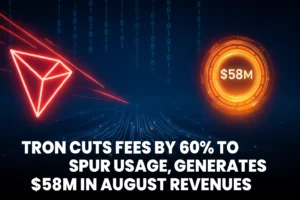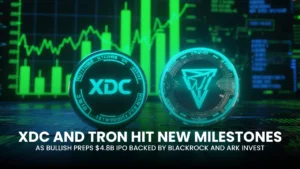67.9M ADA Worth $54.3M Exits Coinbase Into 4.19B Whale Wallet Without Delegation

A single transfer refocused the Cardano debate. On September 29, an entity withdrew 67,926,042 ADA from Coinbase, roughly 54.3 million dollars at the time, and routed the coins to a wallet already holding more than 4.19 billion ADA. The address does not delegate, so none of that balance earns staking rewards.
- The Transfer: What Happened and Why It Matters
- The Wallet: Size, Behavior, and Signals
- Liquidity and Market Microstructure
- Staking, Governance, and the Non-Delegation Puzzle
- Reading the Signals Without Reading Tea Leaves
- What to Watch in the Coming Days?
- Market Scenarios
- Scenario 1: Quiet Cold Storage
- Scenario 2: Float Tightening
- Scenario 3: Re-Deposit And Distribution
- Scenario 4: Deferred Delegation
- Key Data Points
- Conclusion
- Frequently Asked Questions About Cardano Whale Transfer
- How large was the withdrawal in ADA and dollars?
- Which exchange saw the outflow?
- Does the destination wallet stake or delegate its ADA?
- How big is the destination wallet after the transfer?
- Does a big exchange outflow imply a bullish or bearish signal?
- What should investors track next?
- Glossary of Key Terms
The move shrinks tradable float on an exchange, concentrates holdings in a single vault-style wallet, and raises clean questions for investors who track liquidity, custody posture, and governance participation.
While Cardano runs a proof-of-stake design, the episode also echoes a pattern seen across Delegated Proof of Stake, or DPoS, ecosystems where large holders often shape validator economics through delegation.
ALSO READ: Sui Tests Wearables, XDC Foresees $7T in Tokenization, and ARK Buys Tech Stocks
The Transfer: What Happened and Why It Matters
U.Today reported that 67,926,042 ADA left Coinbase for an unknown wallet. At the moment of movement, the haul equaled 54,324,535 dollars. The recipient address already controlled billions of ADA before the transfer, which makes this event an exercise in further concentration, not a fresh build.
The transaction was split, with the larger tranche boosting a destination balance above 4.19 billion ADA. The address does not delegate, so the full stack remains outside staking pools. That choice trades yield for control and, potentially, for operational simplicity.
From a market-structure angle, large outflows can reduce immediate sell pressure on a centralized venue and nudge liquidity toward over-the-counter or self-custody routes. A removal of that size also trims the visible inventory market makers might tap in a fast market, which can widen spreads if offsetting supply does not appear.
None of this predicts price by itself, but it sets the stage investors should watch, namely exchange balances over the next several sessions, any follow-up transfers from the destination, and changes in staking participation if the owner alters course and delegates later.
https://x.com/whale_alert/status/1972528449332916391
The Wallet: Size, Behavior, and Signals
The wallet profile stands out. It now sits north of 4.19 billion ADA, does not delegate, and has processed a high volume of transactions over years. In a network where broad staking participation is common, a non-delegating whale leaves yield on the table.
ALSO READ: TRON Sets New Records in USDT Transfers as Sui Activates Google Payment Agents
That posture signals a preference for unencumbered control, low operational complexity, or a separate risk framework that avoids staking smart-contract exposure. Whatever the motive, the result is a large voting and staking-eligible stake that does not currently contribute to rewards. For governance watchers, the latent power of such holdings matters, since a later switch to delegation can shift pool dynamics and headline metrics.
This is not the first ADA movement of scale flagged by trackers, and it will not be the last. On-chain data has shown periodic transfers between Coinbase and large unknown wallets. The new outflow fits that pattern and invites comparisons to prior episodes that also tightened exchange balances.
A second recent reference from Whale Alert shows a similar Coinbase-to-unknown transfer of 38,644,966 ADA, underscoring that big movements occur in clusters and often around the same venues. Context helps investors separate noise from pattern.
https://x.com/whale_alert/status/1948799700242411801
Liquidity and Market Microstructure
Exchange liquidity is a living metric. A large outflow reduces visible supply on a single venue. If a few big addresses keep drawing down inventories at the same time that retail and smaller funds increase net buys, order books can thin. Thin books amplify price impact for market orders.
In practice, this pushes sophisticated participants toward limited strategies, internalization, and alternative venues. If the whale intends to hold, the float reduction persists. If the whale later re-deposits to sell, the effect can reverse quickly. Both paths rely on the same truth, that a handful of large actors can move inventory across custody rails in minutes.
Investors should watch three things now. First, net exchange balances for ADA across major venues, with Coinbase as an anchor point.
Second, spot-perpetual basis, which reveals whether derivatives markets are leaning long or short as spot inventory changes.
Third, realized spreads and depth at top-of-book, which show whether liquidity providers are stepping in or backing off. The transfer itself is a single data point. The reaction in market-making behavior and funding rates turns it into a market story.
ALSO READ: ARK Invest Returns to Alibaba After a 4-Year Hiatus as Europe AUM Crosses 1B Mark
Staking, Governance, and the Non-Delegation Puzzle
Cardano’s design encourages broad staking through delegation. A non-delegating mega-holder goes against that grain. The decision may reflect internal policy rules, a desire to keep coins inert for accounting reasons, or a compliance framework that separates operational wallets from staking activity.
It could also be a hedge against counterparty or smart-contract risk, even if that risk is limited. The cost is measurable, since staking rewards would otherwise accrue over time. More importantly, a choice not to delegate today leaves open the possibility of a future pivot. If that occurs, pool metrics, ranking tables, and network-level participation statistics will change.
In many Delegated Proof of Stake systems, whales delegate to block producers to secure yields, rebalance incentives, and influence validator health. That is a key contrast. Here, the wallet’s non-delegation removes a lever that DPoS participants often pull. If this owner eventually delegates, pool concentration could shift quickly, which would echo dynamics seen when large DPoS stakeholders migrate between validators.
Reading the Signals Without Reading Tea Leaves
The event invites stories. Resist them. There is no confirmed identity behind the wallet, no public statement of intent, and no evidence of an imminent sell program. What we have is fact: size, route, timing, and the non-delegation detail. Build decisions on those pieces rather than on rumor.
That means tracking exchange inventories, observing whether the coins move again, and watching if any portion touches staking. It also means acknowledging that giant holders often operate with longer horizons and tighter operational controls than traders scanning hourly charts.
The absence of staking is not a verdict on the network. It is a data point about one owner’s posture. The withdrawal from Coinbase does not prove bullish or bearish lean.
It proves that a large holder moved coins into self-custody or a custodian that is not an exchange. In crypto, that is an ordinary act. The size is the story, and the destination’s history adds weight.
What to Watch in the Coming Days?
Follow the recipient address for any outbound flows. Look for test transactions to other fresh wallets. Watch whether any ADA returns to Coinbase or appears on rival exchanges. Track exchange netflows for ADA.
If balances keep shrinking, liquidity providers may widen spreads to reflect inventory risk. If balances stabilize, the impact fades. Also watch staking dashboards. A new delegation from this wallet would show up, and operators would notice quickly. The lack of movement can be as telling as a burst of activity.
Market Scenarios
Scenario 1: Quiet Cold Storage
The coins sit. Exchange balances fall slightly, but market depth holds as other sellers step in. Spreads remain stable. The story becomes a footnote in a steady week. In this path, investors see little follow-through on funding, and basis stays near neutral.
Scenario 2: Float Tightening
A series of similar outflows reduces Coinbase’s ADA inventory. Depth things during busy sessions. Market makers widen quotes, and short-term volatility rises around news. Funding turns positive as traders pay to stay long. If this unfolds, the transfer becomes a signal for a shift in microstructure more than a macro call.
Scenario 3: Re-Deposit And Distribution
The owner tests liquidity across venues. Coins return to exchanges in chunks. Depth improves, and spreads tighten. Funding steadies, and basis normalizes. The episode reads as rotation rather than accumulation. This outcome is most likely if the wallet was staging for a later move rather than for cold storage.
Scenario 4: Deferred Delegation
The coins remain off exchange, then a portion shifts into staking. Pool concentration changes. Operators debate the optics. Rewards begin to accrue. Governance watchers parse how delegation affects stakeholder maps. This path changes the non-delegation narrative and adds a different kind of concentration risk to the conversation.
Key Data Points
| Metric | Value | Why It Matters |
| ADA withdrawn | 67,926,042 | Size defines market relevance and the potential float impact. |
| USD value at transfer | $54,324,535 | Calibrates the move in dollar terms for liquidity planning. |
| Origin | Coinbase | A top U.S. venue, so inventory changes influence visible depth. |
| Destination wallet balance | >4.19 billion ADA | Indicates further concentration in a vault-like address. |
| Staking status | Not delegated | Signals no yield capture and latent governance power. |
| Structure | Split transfer | Suggests operational intent and risk controls. |
| Independent alert | 67.9M ADA to unknown wallet | Confirms movement and timing in real time. |
| Additional context | 38.6M ADA from Coinbase to unknown wallet | Helps identify flow clusters and venue patterns. |
Conclusion
The Coinbase withdrawal of 67.9 million ADA is a clear, verifiable event that concentrates holdings in an already massive, non-delegating wallet. The transfer reduces visible exchange supply in the short run, highlights the role of a few very large addresses in shaping liquidity, and reframes an ongoing discussion about governance participation.
In many Delegated Proof of Stake systems, whales that delegate to validators can shift incentives and throughput dynamics quickly. Here, the absence of delegation changes the calculus and keeps attention on whether this owner stays passive.
For proof of stake and DPoS ecosystems, the signal is operational posture, not rhetoric. Investors should respond with discipline by watching exchange balances, recipient-address activity, and any shift toward delegation. The story is not a prediction. It is a map of where to look next.
Frequently Asked Questions About Cardano Whale Transfer
How large was the withdrawal in ADA and dollars?
It was 67,926,042 ADA, worth about 54.3 million dollars at the time of the move.
Which exchange saw the outflow?
Coinbase processed the outflow. The coins moved to an unknown wallet.
Does the destination wallet stake or delegate its ADA?
No. The wallet does not delegate and therefore does not earn staking rewards.
How big is the destination wallet after the transfer?
The balance sits above 4.19 billion ADA.
Does a big exchange outflow imply a bullish or bearish signal?
On its own, no. It reduces visible exchange supply, which can affect liquidity, but it does not prove the owner’s intent to buy, sell, or hold.
What should investors track next?
Exchange ADA balances, any subsequent movements from the recipient wallet, and changes in staking participation if the owner delegates later.
Glossary of Key Terms
- Exchange outflow: Coins withdrawn from a centralized exchange to a private or external wallet.
- Float: Tradable supply available on venues where market participants transact.
- Delegation: Assigning stake to a pool to participate in block production and earn rewards.
- Delegated Proof of Stake (DPoS): A consensus model where token holders delegate stake to a smaller set of validators that produce blocks.
- Staking rewards: Periodic returns earned by delegating stake to a pool.
- Liquidity: The ability to buy or sell without moving price significantly.
- Depth: The volume available at the best bids and offers.
- Basis: The difference between futures and spot prices, often used to gauge leverage.
- Funding: Periodic payments between long and short perpetual futures positions.
- Governance: Processes and votes that influence protocol settings and resource allocation.




